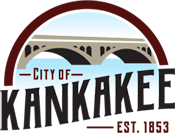-
 Call (815) 933 0502
Call (815) 933 0502
-
 Email Us
Email Us
 City Map
City Map
The Founding of Kankakee
On August 29, 1853, the first edition of the weekly Kankakee Gazette newspaper reported that the city "is rapidly progressing in her building, already 15 or 16 dwellings are in the process of erection. Several stores are near completion...the buildings for the railroad depot are nearly ready for occupancy...." The railroad would call the town Kankakee Depot.

At that time, the town that would become Kankakee did not formally exist: A plat map showing a proposed town of 49 residential and commercial blocks was not filed with the County Recorder until January 14, 1854. The plat was centered upon the Illinois Central railroad station and was bounded by Chestnut Street on the north, Chicago Avenue on the east, River Street on the south, and Entrance Avenue on the west. By the end of the year, various developers had platted "additions" that more than doubled the area of the community, and the population of Kankakee Depot was estimated at just over 1000 people.
A public meeting was held in January, 1855, to formally organize the settlement as a town. A petition requesting a charter was sent Springfield, and on February 15, 1854, Governor Joel Matteson signed the document creating Kankakee City. The new town would be governed by a Board of Trustees. On April 10, 1855, the trustees elected attorney Thomas P. Bonfield as President (in effect, the town's first Mayor).
Ten years later, in 1865, the town changed from a village governed by trustees to a city with a mayor and city council, and shortened its name to the present form, Kankakee. The first Mayor under the new mayor-council charter was merchant William G. Swannell. An unusual provision of the new charter placed the Mayor on the Kankakee County Board of Supervisors as an ex-officio member. That provision was dropped in 1892, when the city abandoned its special charter and was reorganized under the state's general law regarding municipalities.

Coaster Electric Park Early 1900s

Court Street West of Schuyler 1860s

Hotel Riverview



